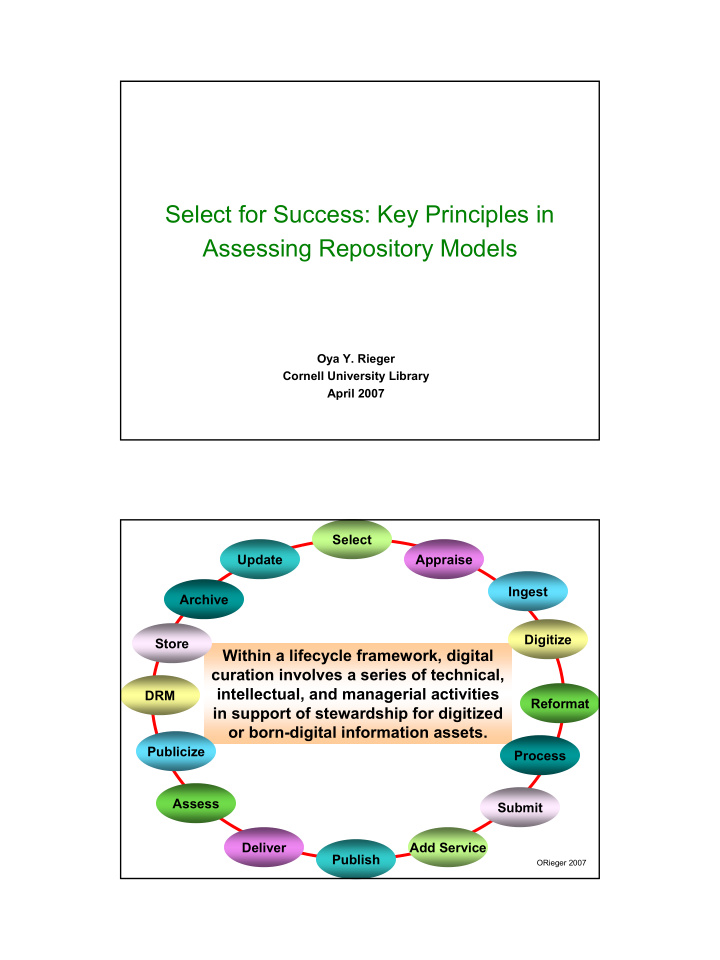



Select for Success: Key Principles in Assessing Repository Models Oya Y. Rieger Cornell University Library April 2007 Select Update Appraise Ingest Archive Digitize Store Within a lifecycle framework, digital curation involves a series of technical, intellectual, and managerial activities DRM Reformat in support of stewardship for digitized or born-digital information assets. Publicize Process Assess Submit Deliver Add Service Publish ORieger 2007 1
What is a repository system? Capture, store, index, manage, preserve, and deliver digital objects. • Digital asset management • Discovery & retrieval • Institutional visibility • Academic support • Scholarly communication • Business procedures support • Innovation in information management DSpace Fedora GreenStone ContentDM Sakai DiVA ePrints Digital Commons DPubS ContentDM Open Journal System aDORe 2
Factors in Choosing a Repository Model • Development characteristics • Support of archival business requirements • Financial sustainability • Content type characteristics • Digital library infrastructure • Preservation functionality • Interoperability and support for standards • Usability (staff and end-user) • Institutional policies and • Search, browse, access features practices Factors in Choosing a Repository Model • Support of archival business • Development characteristics requirements • Financial sustainability • Content type characteristics • Digital library infrastructure • Preservation functionality • Interoperability and support • Usability (staff and end-user) for standards • Search, browse, access • Institutional policies and features practices Art Libraries Society of North America. Digital Image Database Standards Checklist: Technical, Functional, Content, & Access Recommendations Research Libraries Group and OCLC. Trustworthy Repositories Audit & Certification 3
Key Principles in Selecting a Repository Model 1. Identify Key Stakeholders 4
How about OAIS? What is your business case? 5
Let’s implement Fedora Focus on intellectual content 6
Why would I give you my data? Benefits of Stakeholder Analysis • Build awareness • Gather feedback • Build trust • Get support • Expand resources • Understand risks 7
2. Conduct Needs Assessment Document type Condition Metadata attributes documents Selection criteria Usage restrictions Relation to other collections Services Use type users Frequency of use Use mode User support needs Staff and skills Systems, hardware, software Stakeholders resources Organizational guidelines and policies Master plans and strategies 3. Explore Resource Requirement • Start-up costs to be in a range of $8,000-$1,800,000 (with a mean of $182,550) • An average ongoing operating cost of $113,500 Institutional Repositories . SPEC Kit 292. Association of Research Libraries, 2006 LIFE (Life Cycle Information for E-Literature) University College London (UCL), the British Library, JISC 8
Case Study: arXiv Staff = Leadership, management, support, tech development, admin support (9 staff – 4 FTE) Equipment = Servers, back-ups, amortization, storage costs, maintenance Other = Meetings, supplies, communication, software, etc. $25,000 $40,000 Other Equipment Staff Equipment Other Staff, $260,000 9
4. Understand the Existing Human Landscape • Equally important is taking into consideration the existing and evolving work culture and practices. • Traditions and work practices of different communities shape their acceptance and use of technologies. – Relevant social groups (stakeholders) – Interpretive flexibility – Appropriation CSCW & SCOT Approaches that try to “move” faculty and their deeply embedded value systems directly toward new forms of archival systems are destined to fail. Scholarly Communication: Academic Values and Sustainable Models Center for Studies in Higher Education, 2006 10
Key Principles in Selecting a Repository Model • Identify key stakeholders • Conduct needs assessment analysis • Explore resource requirements • Understand the existing human landscape Conclusions • Flexible and scalable repositories At Johns Hopkins, we are promoting the idea that applications should access repositories through an abstract, repository agnostic layer, rather than through custom application to repository integrations. Choudhury and Martino, 2005 11
Conclusions • Flexible and scalable systems • Web services Conclusions • Flexible,scalable • Web services • Repurposing 12
Conclusions • Flexible and scalable • Web services • Repurposing • New information chain Van de Sompel et al , D-Lib Magazine , September 2004 13
Recommend
More recommend